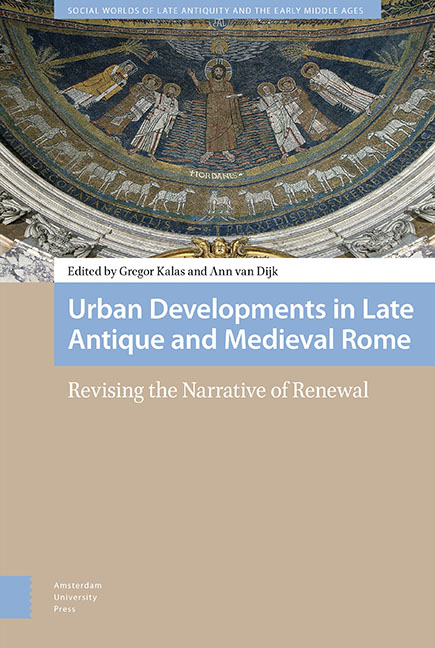Book contents
- Frontmatter
- Contents
- Preface and Acknowledgments
- List of Abbreviations
- 1 Introduction: Revising the Narrative of Renewal for Late Antique and Medieval Rome
- 2 Rome at War: The Effects of Crisis on Church and Community in Late Antiquity
- 3 Portraits of Poets and the Lecture Halls in the Forum of Trajan : Masking Cultural Tensions in Late Antique Rome
- 4 Rolling Out the Red Carpet, Roman-Style : The Arrival at Rome From Constantine to Charlemagne
- 5 (Re-)Founding Christian Rome: The Honorian Project of the Early Seventh Century
- 6 After Antiquity: Renewing the Past or Celebrating the Present? Early Medieval Apse Mosaics in Rome
- 7 The Re-Invention of Rome in the Early Middle Ages
- 8 Rewriting the Renouveau
- 9 Renewal, Heritage, and Exchange in Eleventh-Century Roman Chant Traditions
- 10 Reforming Readers, Reforming Texts: The Making of Discursive Community in Gregorian Rome
- Manuscripts Cited
- Index
4 - Rolling Out the Red Carpet, Roman-Style : The Arrival at Rome From Constantine to Charlemagne
Published online by Cambridge University Press: 18 June 2021
- Frontmatter
- Contents
- Preface and Acknowledgments
- List of Abbreviations
- 1 Introduction: Revising the Narrative of Renewal for Late Antique and Medieval Rome
- 2 Rome at War: The Effects of Crisis on Church and Community in Late Antiquity
- 3 Portraits of Poets and the Lecture Halls in the Forum of Trajan : Masking Cultural Tensions in Late Antique Rome
- 4 Rolling Out the Red Carpet, Roman-Style : The Arrival at Rome From Constantine to Charlemagne
- 5 (Re-)Founding Christian Rome: The Honorian Project of the Early Seventh Century
- 6 After Antiquity: Renewing the Past or Celebrating the Present? Early Medieval Apse Mosaics in Rome
- 7 The Re-Invention of Rome in the Early Middle Ages
- 8 Rewriting the Renouveau
- 9 Renewal, Heritage, and Exchange in Eleventh-Century Roman Chant Traditions
- 10 Reforming Readers, Reforming Texts: The Making of Discursive Community in Gregorian Rome
- Manuscripts Cited
- Index
Summary
Abstract
The arrival ceremony (adventus) provides important insights into the social imaginary of late antique Rome. On the one hand, the adventus visibly highlighted the power of those arriving. On the other hand, the city presented a version of itself in the form of the welcoming committee. How, for whom, and by whom these arrivals were staged reveals the changing ways that Rome was imagined. Though the ceremony remained deeply traditional for a very long time – emperors greeted by the senate and Roman people – over centuries, the ritual was slowly adapted to suit a Christianizing city. Bishops not only joined the welcoming committee, but they themselves were welcomed back into Rome in grand style.
Keywords: adventus (arrival ceremony), Christianization, late antique Rome, performance, processions, triumph
And so we came to Rome. Brothers from that place, when they heard about us, came as far as the Forum of Appius [65 km] and Three Taverns [50 km] to meet us.
Acts 28:14–15In a way, Paul's arrival may be the first Christian adventus (arrival ceremony) at Rome. As Paul and his entourage (a centurion named Julius, other prisoners, and the narrator of Acts) approached the city, two different groups of brothers, and possibly also sisters (adelphoi), greeted him at great distances from the city. At Rome, Paul was allowed to live in rented rooms with the soldier who had accompanied him on his journey. Then, on the third day after his arrival, Paul assembled and spoke to the leaders of the Jewish community. Whatever may have really happened, the author of Acts certainly described how a figure like Paul should have been greeted, following, more or less, the standard pattern for a ritualized arrival at Rome: a joyous greeting outside the city by some representative group, an address to (some of) the citizens and/or an offering of thanks for a safe arrival, and the assumption of his or her residence.
This pattern had been set by the late Republic, when Cicero returned from exile in 57 BCE. According to Cicero himself, ‘the Roman people honored me with their large and joyful escort from the gate to the Capitol and from there to my house.’
- Type
- Chapter
- Information
- Urban Developments in Late Antique and Medieval RomeRevising the Narrative of Renewal, pp. 109 - 148Publisher: Amsterdam University PressPrint publication year: 2021



